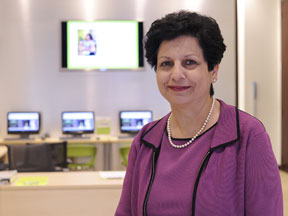A new initiative to educate area residents about managing diabetes is especially important in Alabama, where the American Diabetes Association says one in three citizens born after 2000 are likely to develop the disease.
 |
| Mona Fouad and the Minority Health & Health Disparities Research Center are part of a new innovative pilot project called Cities for Life. |
Cities for Life is an innovative pilot project made possible with support from Sanofi US that will work with community groups to create an environment that encourages healthy lifestyles and disease management by linking residents living with or at risk for diabetes with available resources.
UAB’s Department of Family & Community Medicine, Diabetes Research and Training Center’s and UAB HealthSmart are working with the City of Birmingham, YMCA of Greater Birmingham and the American Academy of Family Physicians (AAFP) Foundation for this unique clinic-community pilot project.
“We’re an academic center with many resources and expertise that fit well with this project,” says Mona Fouad, M.D., director of the Minority Health & Health Disparities Research Center.
“Through the DRTC and HealthSmart we’re going to be able to find the partners, raise awareness and bring the communities to the solution,” Fouad says. “We always say if the problem is in the community, the solution is in the community.”
Cities for Life is a grassroots program that will leverage the collective strength of Birmingham’s medical neighborhood, including health-care and educational opportunities through UAB, family medicine practices and many community resources to support a healthy lifestyle.
UAB’s Department of Family & Community will identify clinics in the communities of Southside, Southwest, Homewood, Titusville and West End that can help.
Only city selected
Birmingham was selected for Cities for Life from among more than 50 contenders because Alabama has one of the nation’s highest rates of diabetes and the city has a demonstrated commitment to improving the lives of its citizens.
A key component of Cities for Life is the use of a patient navigator to work directly with family medicine practices to help build links between community resources and people living with or at risk for diabetes. The AAFP National Research Network, the country’s largest practice-based research network, will work closely with key community partners to help develop the patient-navigation system and guide patients to appropriate, accessible resources.
“Our goal is to improve the health of patients and to look at certain scientific and research opportunities and educational opportunities,” says Mary Jo Welker, M.D., president of the AAFP Foundation. “This program fits that need perfectly. We’ll be working with UAB’s Department of Family and Community Medicine and the community to improve the health of the population. We’ll do some studies to try and determine what works and what doesn’t, what kind of incentives might encourage people to change their lives. Then we want to take those educational opportunities and best practices to other communities to help them do the same kinds of things.”
The key partners, representing both the community and the clinical perspectives, will make project decisions on implementation and sustainability through a Cities for Life steering committee. The group says designing a patient-centered link is the first step.
Next steps include increasing awareness through social marketing and linking to diabetes resources through civic and community groups that are focused on peer-support and self-management. Finally, the program will attempt to incorporate principles of behavioral economics —personal and financial incentives for behavioral change — by connecting to local businesses that value the health of their employees and customers.
Fouad says the obstacles for many of these people are the barriers they face once they are diagnosed and given their medications and guidelines for disease management.
“There are no safe places to walk, no access to good food and in many instances there are hardships in transportation to access places to get their medicines,” Fouad says. “There is no education on managing diabetes and its side-effects if not managed. And there is hopelessness among some that they can’t do anything about it.
“Now patients will have a more comprehensive approach to manage their diabetes,” Fouad says.
